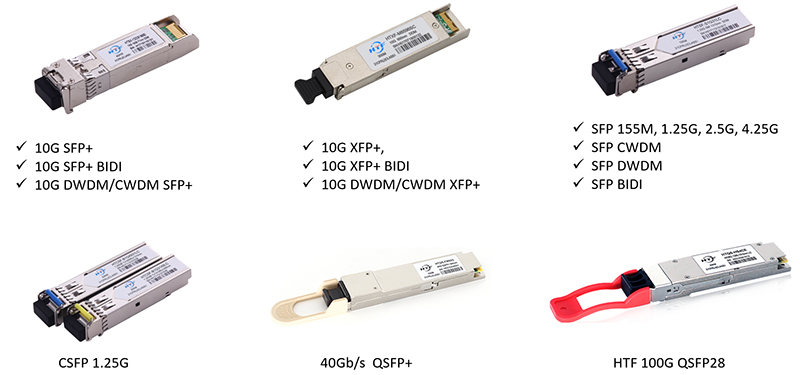People commonly use SFP transceivers to connect network devices and cables. With the increasing range of applications, many 1G SFP transceivers are available. However, choosing the right 1G SFP modules for your specific requirements can be difficult.
If you are considering upgrading your switches and are unsure how to select the right 1G SFP optical modules, this blog aims to provide practical guidance. It will assist you in choosing an optical module that offers a combination of high compatibility and cost-effectiveness.
7 Factors to Choose 1G SFP Transceivers
SFP Network Technology
1G SFP transceivers are available in a range of models, each designed to cater to different networking technologies. These SFP module types are tailored to specific networking standards and can be classified as Ethernet SFP, FC SFP, SDH SFP/SONET SFP, or PON SFP.
Ethernet SFP modules are extensively utilized in enterprise networks for high-speed data transfer between switches, routers, and other networking equipment.
FC SFPs are designed for fiber channel storage in data centers and are commonly used in enterprise Storage Area Networks (SANs).
SONET/SDH SFPs are popular in telecom systems for their high-speed, long-distance data transfer. They can support different transmission rates and reach distances, making them flexible and ideal for various network topologies.
PON
SFPs are specifically designed for various fiber-based (FTTx) access networks, making them ideal for delivering exceptional video, voice, and data services to both residential and commercial environments.
SFP Network Technology
Transmission Medium
1G SFP module types are available to support both single-mode and multimode fiber (Fiber SFP), as well as twisted-pair copper cables such as Cat5e, Cat6 and Cat6a (Copper SFP). If the endpoints are close enough (for example, less than 100m), it‘s wise to use copper SFP modules. However, when the distance is significant or there is a need to prevent cross-talk between cables, opting for fiber SFPs is a better choice. Commonly, the 1G SFP EXZ module supports up to 160km transmission via single-mode fiber.
Wavelength
In fiber optics, make sure you use the right wavelengths on each side, otherwise, the transmission will fail. For 1G dual fiber SFP, 850nm, 1310nm, and 1550nm are the most used wavelengths, while 1G BIDI module‘s wavelength includes TX1310/RX1550nm, TX1550/RX1310nm, TX1490/RX1550nm, TX1550/RX1490nm, TX1310nm/Rx1490nm and TX1490nm/Rx1310nm. Note that, both 1G dual and BIDI fiber modules should be used in pairs. Dual fiber SFP modules must have the same wavelengths at each point, while BiDi SFPs use the opposite wavelength together.
Working Temperature
The operating temperature range is a critical consideration, especially in environments with extreme temperature variations. Industrial 1G SFP modules are designed to withstand wider temperature ranges, typically from -40°C to 85°C, while commercial-grade modules are suitable for standard temperature ranges of 0°C to 70°C. Assess the environmental conditions where the 1G SFP transceivers will be deployed and choose the appropriate temperature range accordingly.
Compatibility
Compatibility issues can lead to connectivity problems and impact overall network performance. The compatibility of SFP is determined by the inclusion of specific brands and models of equipment. To verify device compatibility, you can refer to the SFP compatibility matrix available on the official website of the equipment brand or consult your vendors for assistance.
HTF provides multiple brands of compatible transceiver modules, some of the main-stream brands are Cisco, HP, Juniper, Brocade, Dell, Extreme, H3C, Arista, Huawei, Intel, IBM, Netgear, Ciena, D-Link, Avago, F5 Networks, Avaya, Alcatel-Lucent, Aruba Networks, Allied Telesis, SMC Networks, TRENDnet, etc.
DOM Support
Opting for high-quality SFP modules is essential for reliable and efficient network operations. Consider features such as Digital Optical Monitoring (DOM), which provides real-time monitoring of optical parameters like power levels, temperature, and signal quality. Investing in quality modules with advanced monitoring capabilities can help in proactive network management and troubleshooting.
Price & Budget
Compare prices from different vendors to get a sense of the market range for 1000Base SFP modules. Keep in mind that excessively low-priced modules may indicate lower quality or compatibility issues, while excessively high-priced modules may not necessarily offer significant added value. Look for a balance between cost and quality.
In addition to comparing 1G SFP transceiver prices from various manufacturers, it‘s essential to explore if there are more cost-effective alternatives available. For instance, if you require an end-to-end connection between two switches within the same rack and the distance is short, you might consider using a high-speed cable that eliminates the need for additional fiber cables.
Conclusion
This guide provides practical tips on factors to consider, such as SFP network technology, medium support, wavelength, working temperature, compatibility and DOM support to help you make an informed decision. You could click the article How Many Types of SFP Transceivers Do You Know? to get more information. If you are still facing difficulties in purchasing 1G SFP transceivers. Please feel free to reach out to our sales expert through the chatbox or send us an email at ivy@htfuture.com.





没有评论:
发表评论